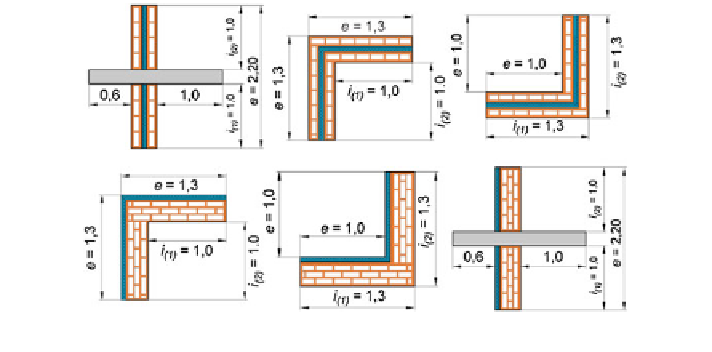Civil Engineering Reference
In-Depth Information
Fig. 7
Structural linkages—B1.b and B1.d
influence of the methodology is rather significant: in case B1.a, the simplified
procedure brought to a value of EP
H, env
which accounts for 22.2 % of the value
obtained for B1.b.
The evaluation of the energy needs for B1.c and B1.d highlights a higher
dependence of the results on the assessment method for thermal bridge than in the
previous analysis: in fact, different energy classes were obtained. This gap is
determined by the influence of thermal bridges which increases according to the
reduction in opaque elements' thermal transmittance. This is the reason which
entails a worse class using the analytical method, even if the simplified calculation
was performed by choosing the most increasing percentage of thermal transmit-
tance provided by the standards.
These analyses highlight not only the variation of the results, depending on the
calculation method using same parameters, but also show that, for existing
buildings with initial high energy needs, the insulation of the opaque elements
assures a remarkable improvement in the performances, but the energy class
reached is still far from the A class.
Consequently, it is necessary to design other kinds of intervention for the
building envelope, such as the substitution of the windows, with U
window
= 1.5 W/
(m
2
K).
Cases A2.a and A2.b are based, respectively, on case A1.a and A1.b with the
addition of new windows, while case A2.c simulates only window substitution,
without opaque element insulation. As it is expected, the best class is reached with
a combination of external insulation and high-performance windows, which brings
to E class, while the mere substitution of transparent elements allows an energy
saving of just 3 % and does not improve the energy class.
Table
4
highlights how the differences among calculation methods of thermal
bridges can bring to different energy performance classes (case B2.a and B2.b),
anyway far from A class. On the other hand, for case B, it is possible to derive some
other considerations: in fact, in this case, the transparent surfaces represent 13 % of

